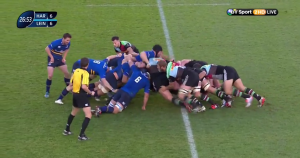High tackles are never celebrated. Spears are never praised. We’re told that tackling a player in the air is cowardly.
But dangerous scrummaging, we’re told, is a “dark art”.
In the past number of weeks, I’ve come across two viral videos that demonstrate just how poorly policed the scrums have become.
The first was back in October, from an ITM Cup game between Manawatu and Hawke’s Bay.
Canadian prop Hubert Buydens lifts his countryman Jason Marshall off the ground and out of the scrum by driving upwards in an incredibly dangerous manner, somehow winning his side a penalty.
Even the thumbnail below demonstrates just how high Marshall is lifted, and by refusing to pop out of the scrum for so long, past experience can tell me that Marshall is not able to breathe.
The internet reaction to Buydens’ was that he was a “beast”, and the site I initially saw the video on went on to say that he “dished out a scrummaging lesson” in the process.
More recently, another video, again involving a Canadian prop on the receiving end, made me worry even further just how little protection players have at scrum time.
Romanian loose-head Mihai Lazăr continually drove Andrew Tiedemann up into the air, and despite his flanker repeatedly pointing out the dangerous play to referee Nick Briant, the New Zealander staggeringly awards a penalty to Romania.
The relaxed attitude to dangerous play at the scrum is incredibly alarming.
In Sunday’s game between Harlequins and Leinster, Joe Marler won a number of penalties for deliberately driving up and in against Mike Ross, to which BT Sport co-commentator Matt Dawson said: “All loose-heads drive up. That’s just a shoeing.
“We can get too technical about it if we want. Mike Ross has dealt with plenty of loose-heads that work a worse angle than that.”
Despite acknowledging that Marler was deliberately forcing his opponent up, Dawson continued: “Also what I love about that is Danny Care screaming at the touch judge, saying, ‘Are you looking at this? Are you seeing how much Marler is destroying Ross in that scrum'”?
Not only does it show rugby’s common motto that rules are there to be broken, it also enables dangerous scrummaging further.
If Dawson, or any other rugby commentator for that matter, saw Marler crush an opponent with a high or spear-tackle, you can bet your life that he wouldn’t be heaping praise on him.
It’s a universal problem for the sport, with every side in every part of the world guilty of doing at it some point.
When a scrum collapses, the front and second row players crash into the ground head-first, and because they are bound to other opponents, they have nothing to break their fall.
To take one example of a collapsed scrum, have a look at where Mike Ross’ head ends up after a collapse during the Ireland-Georgia game last month. It’s not natural, and accepting this as part of the game isn’t acceptable.
And it’s equally as dangerous when you’re driven upwards. With so much pressure coming towards you, and a second row fighting the shove from behind, as a prop your back gets sandwiched, and if the force is strong enough and the prop being lifted is determined enough not to pop out of the scrum, your back and neck can be arched to an unnatural extent you can no longer breath.
We’re heading down a road where players are getting bigger and bigger, and the forces meeting in the scrum are only continuing to grow.
By failing to clamp down on dangerous scrummaging, and indeed by praising those who engage in it, it is creating a path for more and more players to do it.
Boring in and dropping the bind is being taught and encouraged at junior and underage level, as oblivious coaches are seeing it praised by analysts and pundits, rather than discouraged for being dangerous.
With so many binds, angles and players to control at the scrum, referees are relying on presumptions and guess-work, routinely awarding penalties on the basis of which team was moving forward, rather than which player was bending both the rules, and often times his opponent.
Referees have a duty to protect the players on the pitch, and if a dangerous bind or angle is spotted, it should be penalised instantly, rather than waiting for the scrum to collapse and play roulette with a player’s neck.
World Rugby have made a serious clamp-down in recent seasons on spear-tackles and tackling players in the air, rightly dishing out yellow and red cards, regardless of the injury that occurs.
And it’s high time they became brave and did the same for forwards who take their opponents’ lives into their hands at the scrum.
Hopefully tragedy doesn’t strike before they do.






























